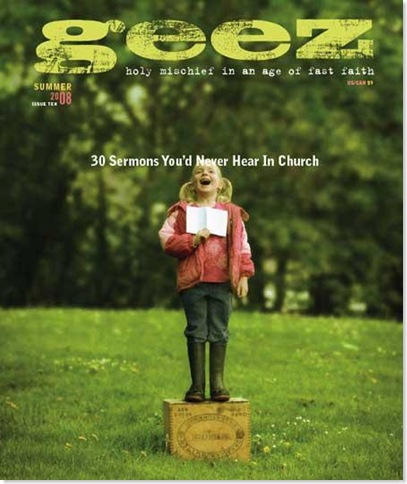Now on magazine stands near you…GEEZ…30 sermons you’d never hear in church.
Whether playful, mischievous, or serious, there’s a foyer full of artful, imaginative, and compelling sermons here; and as promised, nary a one will you hear in church. (Also between these covers…my own “detoxification sermon.”)
An excerpt: Genuine worship is a detoxification process. It’s about releasing our fascination with who’s in and who’s out. It’s about letting go of our obsessive competitiveness that reduces us to shadows of each other. It’s about escaping the grip of this acquisitive fascination with one another in order to truly encounter and be open to one another.
While I’m always gratified to be published and thankful for being given a voice, I have to immediately add that this “sermon” owes its life to the thought of James Alison. (See below for the full detox.)
The Detoxification Sermon (GEEZ Summer 2008)
“Worship is the high and holy art of spiritual architecture…” -Dr. Leonard Sweet,
Now I’m sure, asked again about worship, Dr. Sweet would expand and qualify. My point with this quote is simply to point out that in practice contemporary Christian worship is understood to be about producing an atmosphere of high anticipation, a sweep of holy enthusiasm, a spirit of godly unity. And here, while it is theologically acknowledged that the One worshiped is already and always present, what is rehearsed is producing a mood that encourages God to show up. Worship, it appears, needs orchestration, needs an architect.
 We are scarcely aware of how, and how often, we are caught up in the “architecture of worship.” From the carefully crafted emotional pitches for products that ensure us a correct lifestyle, to the religiously charged political rally, we engage in worship. It’s a high and unholy industry. And we are all susceptible to being duped by this ersatz worship and its blanketing effect of mimetic fascination. And under this blanket we are scarcely aware of how worship can become a form of exclusion and a prelude to violence.
We are scarcely aware of how, and how often, we are caught up in the “architecture of worship.” From the carefully crafted emotional pitches for products that ensure us a correct lifestyle, to the religiously charged political rally, we engage in worship. It’s a high and unholy industry. And we are all susceptible to being duped by this ersatz worship and its blanketing effect of mimetic fascination. And under this blanket we are scarcely aware of how worship can become a form of exclusion and a prelude to violence.
I remember the irresistible pull of belonging to the right group of Christians. I remember how much I thought I needed this. And with distance I can now remember moving with a certain self-righteous priggishness that knows itself to be on the inside—countenanced of course by a veneer of humility. It happens.
That’s why distinguishing genuine worship from worship makes all the difference in the world. There is nothing inherently wrong with contemporary styles of Christian worship. Nothing wrong with emotional and spirited celebration of God. But when there exists, or when there is encouraged a sense of moral distinction within the worshiping group, “spirited” worship can produce a lie. It can produce an abstraction, a reduction of particularities, a spirit of sameness as opposed to real unity, an enclave instead of an unfolding congregation.
When Christian worship subtlety links itself to patriotism, or leans into pietism and moralism, worshipers can soon identify themselves not simply as believers, but as “true believers.” And the category “true believers” is only sustainable as being over and against what isn’t “true.” That is, over Muslims, Jews, gays and lesbians, atheists, communists, Catholics, Protestants, and so on. And as Christian history shows, this is tinder for rivalry and violence. Of course worship, as in group-defining architecture, works for any assembly and in any direction.
But in real Christian worship no high or holy architecture is needed. There is nothing to produce. Everything has been concluded. Worshiping Christians are nothing more than witnesses to something done and transpired. Witnesses to the “forgiving victim.” The victim who has absorbed our exclusion and victimizing violence and in return, forgives. And in this forgiveness our ever again needing to secure ourselves by being part of an “us against them” is undone.
Genuine Worship is a detoxification process. It’s about releasing our fascination with who’s in and who’s out. It’s about letting go of our obsessive competitiveness that reduces us to shadows of each other. It’s about escaping the grip of this acquisitive fascination with one another in order to truly encounter and be open to one another.
True Worship, as theologian James Alison contends, “…leads to a slow, patient discovery of being able to like people in their bizarre particularities, and see the beauty in those things, not abstract from them.” The test of true worship then is finding yourself beginning to receive others specifically within their peccadillo’s and annoyances and not as “loving the brotherhood,” as abstracted beyond persons with personalities through a grand unifying purpose, Christian or otherwise.
What this means is that real Christian worship is relaxing, and in some sense entirely unremarkable. It is ascetical. It is the long discipline of removing whatever distracts us from inhabiting the hidden, unassuming presence of Jesus who is “simply here.” It is about becoming unexcited, un-aroused, un-fascinated, so as to grow attentive to what and who is around us. And in this restful attentiveness flourishes true hospitality and peace. And this is always contemporary.
Here’s a little litmus test: If you’ve been attending worship for years and still find yourself duking it out at church business meetings, still find yourself wishing not altogether pleasant things upon the irascible Mrs. Smith, then stop “going to worship” already, and begin worshiping.
Stephen T. Berg



Congratulations on your article being published. I like the litmus test idea…